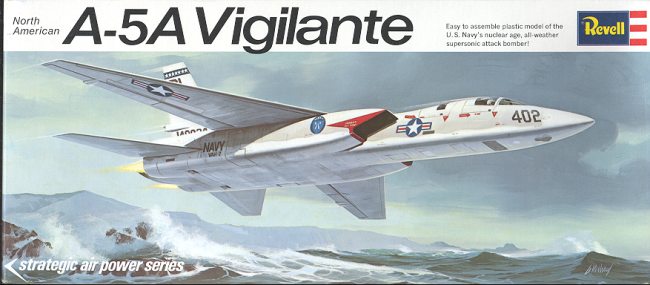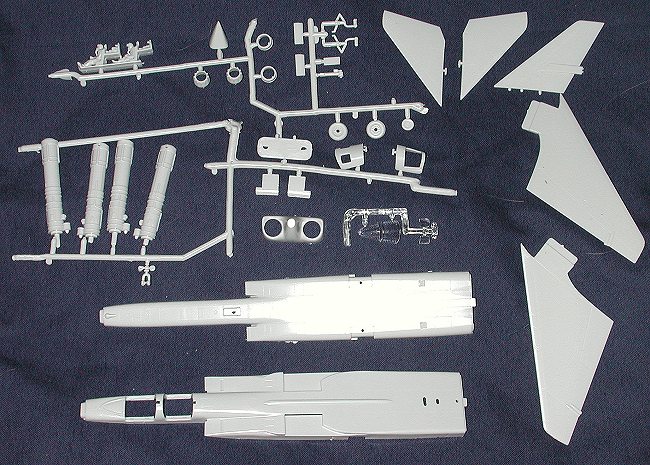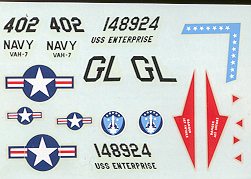
| KIT: | Revell 1/83 A-5A Vigilante |
| KIT # | H-134 |
| PRICE: | $1.00 in 1968 |
| DECALS: | One aircraft |
| REVIEW & | |
| NOTES: | This is a real oldie |

| HISTORY |
During the 50's, there was a major struggle between the USAF andthe Navy over who could offer the best nuclear deterrent. The Air Force had avery large fleet of nuclear capable bombers. The Navy basically only had a fewcruise missiles, and those were not very good. The ballistic missile sub wasstill a bit away from being operational with the Polaris missile, so it was feltthat a nuclear strike bomber (one to replace the A-3) was needed.
The requirements were for it to be supersonic, able to operatefrom aircraft carriers and have the ability to carry a single weapon. The resultwas the imaginative A-5A. North American developed a very large, two seat, mach2 aircraft. The weapon was loaded between the engines from the rear. It wasejected from the back as the aircraft sped away to escape the blast.
In mid-1961, the first Vigilantes entered service with VAH-3,the training unit. It became apparent that this was not only a very capableaircraft, but also one that would brook no fools. The aircraft was verydemanding on its pilot, especially during landing and low speed maneuvers. Itwas also found to be rather maintenance intensive. However, it was a superbaircraft in all respects, fully capable of performing the mission it wasdesigned for. It eventually was issued to VAH-1 and VAH-7 before the Navy pulledthe plug on having nuclear strike capability in 1963. By this time, the firstPolaris submarines were in service and it was felt that the A-5 was redundant.Fortunately, North American had seen the writing on the wall and had proposedthe recce version, the RA-5C. All the remaining A-5As were converted and theaircraft went on to prove itself a supberb photo platform.
| THE KIT |

This is one of the infamous box scale kits that were so prevalent in the 50'sand 60's. Eventually Revell, Monogram and others got the idea and went with the'normal' 1/72 and 1/48 scales. The first thing that caught my eye is that thiskit has engraved panel lines! That is quite an undertaking for a 60's kit.I also noted that the wings, stabilizers and tail were a single piece. Noproblem except that one side of these has ejector pin marks on them. Some on thewings have been cleverly disguised as fuel fillers, having a row of sunkenrivets around them. However, they will need to be filled and sanded smooth.
The rear stabilizers are supposed to be moveable, but the small attachments willsoon break off. Landing gear are a bit toy like and the wheel wells are shallowand devoid of detail. Two complete engines are provided, ostensibly so that youcan remove them to gaze with wonder at the detail. To me, they will just makethe kit tail heavy. The burner cans are also not that well done, but passable.Another area that will need a bit of work is the nose cone. This one has somerather squared off corners. I think they should be rounder. The cockpit is oneof those great old Revell ones, complete with crew members; sitting rigidly withthe control sticks clutched firmly in their hands. Fortunately, not much will beseen through the badly distorted clear bits.
 Instructions are just what youwould expect from an old dog like this one. Seven easy to follow assembly stepswith generic paint callouts. No separate decal or camo chart. The decals arepart of the last step and painting info is to be gleaned from the box top.Decals themselves look quite good, and despite being 30 plus years old, couldprobably be used if coated with some Microscale decal film. They are for VAH-7,which made several cruises on the USS Enterprise . The sheet gives theshore tail code of GL along with an appropriate shore nose number in the 4xxrange. To do a cruise A-5A, the tail code will have to be changed to AF or AEand the nose number to a 7xx.
Instructions are just what youwould expect from an old dog like this one. Seven easy to follow assembly stepswith generic paint callouts. No separate decal or camo chart. The decals arepart of the last step and painting info is to be gleaned from the box top.Decals themselves look quite good, and despite being 30 plus years old, couldprobably be used if coated with some Microscale decal film. They are for VAH-7,which made several cruises on the USS Enterprise . The sheet gives theshore tail code of GL along with an appropriate shore nose number in the 4xxrange. To do a cruise A-5A, the tail code will have to be changed to AF or AEand the nose number to a 7xx.
Bottom line. This is an old kit that would be one which would be sought bycollectors. It is probably not ultra-accurate and will not hold up well againstmodern kits. However, it is the only A-5A done in injected plastic and despiteits age and odd scale, can probably be made into a very nice model.
| REFERENCES |
Wings of Fame #19, North American A-5 Vigilante, byM.Hill Goodspeed, 2000
Review kit courtesy of me and my wallet!
If you would like your product reviewed fairly and fairly quickly by asite that has over 1,700 visits a day, please contactme or see other details in the